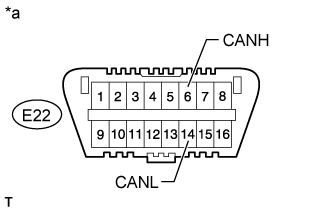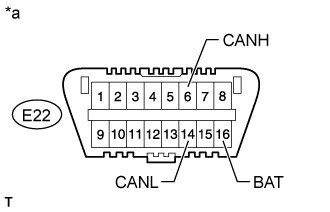Can Communication System (For Rhd Without Central Gateway Ecu) How To Proceed With Troubleshooting
Networking. Land Cruiser. Urj200, 202 Grj200 Vdj200
IMPORTANT POINTS CONCERNING TROUBLESHOOTING
VEHICLE BROUGHT TO WORKSHOP
INSPECT BATTERY VOLTAGE
CHECK FOR DTC*
CHECK INSTALLED SYSTEMS (ECU AND SENSOR) THAT USE CAN COMMUNICATION
CHECK FOR OPEN CIRCUIT IN DLC3 CAN BRANCH WIRE AND V BUS CIRCUIT CAN MAIN WIRE AND SHORT CIRCUIT (CANH - CANL)
CHECK FOR SHORT TO B+ IN CAN V BUS (CANH, CANL - BAT)
CHECK FOR SHORT TO GND IN CAN V BUS (CANH, CANL - CG)
CHECK ECUS CONNECTED TO CAN BUS*
CHECK COMMUNICATION MALFUNCTION DTC (PAST DTC CHECK)*
CHECK DTC COMBINATION TABLE (V BUS CAN BRANCH WIRE OPEN, PAST COMMUNICATION STOP MALFUNCTION)
PERFORM MALFUNCTION SIMULATION TEST (V BUS CIRCUIT CAN MAIN WIRE PAST MALFUNCTION)*
ADJUST, REPAIR AND REPLACE
CLEAR DTC*
CONFIRMATION TEST
Can Communication System (For Rhd Without Central Gateway Ecu) -- How To Proceed With Troubleshooting |
| IMPORTANT POINTS CONCERNING TROUBLESHOOTING |
- CAUTION:
- Wait at least 90 seconds after disconnecting the cable from the negative (-) battery terminal to disable the SRS system.
- NOTICE:
- Refer to the troubleshooting procedures of each system if DTCs regarding the CAN communication system are not output.
- Before measuring the resistance, leave the vehicle for at least 1 minute and do not operate the ignition switch, any switches or any doors. If doors need to be opened in order to check connectors, open the doors and leave them open.
- After turning the ignition switch off, waiting time may be required before disconnecting the cable from the battery terminal. Therefore, make sure to read the disconnecting the cable from the battery terminal notice before proceeding with work (Click here).
- When disconnecting the cable, some systems need to be initialized after the cable is reconnected (Click here).
- HINT:
- Operating the ignition switch, any switches or any doors triggers related ECU and sensor communication with the CAN, which causes resistance variation.
- *: Use the GTS.
DTCs indicating a CAN communication malfunction are also stored due to internal or power source-related problems in ECUs or sensors of systems using CAN communication. Therefore, check whether codes indicating internal or power source-related problems in those systems are output together with the CAN communication DTCs.
It is possible to inspect the circuit of the DLC3 CAN branch wire or V bus CAN main wire for malfunctions by inspecting the terminals of the DLC3 using SST.
- NOTICE:
- It is only possible to inspect CAN branch wires to ECUs (sensors) or the V bus from the DLC3.
It is possible to check which ECUs (sensors) are not able to communicate via CAN communication by checking the "Bus Check" function of the GTS (when the DLC3 CAN branch wire and V bus CAN main wire are normal).
- HINT:
- When checking "Bus Check", ECUs (sensors) whose CAN branch wire is open or that cannot communicate via CAN communication do not respond to the GTS (they are not displayed on the screen).
- When checking "Bus Check", if a DTC indicating a CAN communication malfunction is output even though all ECUs (sensors) respond (they are displayed on the screen), use the DTC combination table to determine the suspected trouble area and perform symptom simulation.
For past malfunctions of the V bus, the ECUs (sensors) which cannot communicate via CAN communication can be determined from the combination of CAN communication DTCs that are output.
The main body ECU (multiplex network body ECU) detects malfunctions in the sub bus 1 circuit and stores DTCs depending on the malfunctioning areas. The ECUs (sensors) which cannot communicate via CAN communication can be determined from the combination of CAN communication DTCs that are output.
When an open circuit malfunction is confirmed, before disconnecting the connectors for inspection, check whether the connectors are loose by pushing in the connector case.
When a connector is disconnected, check if the connector terminals or case is damaged, deformed, deteriorated, etc.
| 1.VEHICLE BROUGHT TO WORKSHOP |
| 2.INSPECT BATTERY VOLTAGE |
- Standard voltage:
- 11 to 14 V
If the voltage is below 11 V, recharge or replace the battery before proceeding.
Using the GTS, check for all DTCs.
- NOTICE:
- If codes indicating internal or power source-related malfunctions of ECUs or sensors are output together with codes indicating that those ECUs or sensors cannot communicate via CAN communication, it is likely that the problem is not in the CAN communication line. Therefore, perform troubleshooting for the DTCs related to the malfunctioning parts first.
- If a connector of a system which includes a CAN communication line is disconnected when the ignition switch is ON or ACC, CAN communication DTCs will be stored by that system and any related systems.
| 4.CHECK INSTALLED SYSTEMS (ECU AND SENSOR) THAT USE CAN COMMUNICATION |
Based on the vehicle equipment and specifications, confirm the systems that use CAN communication (Click here).
| 5.CHECK FOR OPEN CIRCUIT IN DLC3 CAN BRANCH WIRE AND V BUS CIRCUIT CAN MAIN WIRE AND SHORT CIRCUIT (CANH - CANL) |
Disconnect the cable from the negative (-) battery terminal before measuring the resistances of the CAN main wire and CAN branch wire.
Measure the resistance according to the value(s) in the table below.
- Standard Resistance:
Tester Connection
| Condition
| Specified Condition
| Proceed to
|
E22-6 (CANH) - E22-14 (CANL)
| Cable disconnected from negative (-) battery terminal
| OK (54 to 69 Ω)
| A
|
E22-6 (CANH) - E22-14 (CANL)
| Cable disconnected from negative (-) battery terminal
| NG (Higher than 70 Ω)
| B
|
E22-6 (CANH) - E22-14 (CANL)
| Cable disconnected from negative (-) battery terminal
| NG (Below 53 Ω)
| C
|
Text in Illustration*a
| Front view of DLC3
|
| 6.CHECK FOR SHORT TO B+ IN CAN V BUS (CANH, CANL - BAT) |
Measure the resistance according to the value(s) in the table below.
- Standard Resistance:
Tester Connection
| Condition
| Specified Condition
|
E22-6 (CANH) - E22-16 (BAT)
| Cable disconnected from negative (-) battery terminal
| 6 kΩ or higher
|
E22-14 (CANL) - E22-16 (BAT)
| Cable disconnected from negative (-) battery terminal
| 6 kΩ or higher
|
Text in Illustration*a
| Front view of DLC3
|
| 7.CHECK FOR SHORT TO GND IN CAN V BUS (CANH, CANL - CG) |
Measure the resistance according to the value(s) in the table below.
- Standard Resistance:
Tester Connection
| Condition
| Specified Condition
|
E22-6 (CANH) - E22-4 (CG)
| Cable disconnected from negative (-) battery terminal
| 200 Ω or higher
|
E22-14 (CANL) - E22-4 (CG)
| Cable disconnected from negative (-) battery terminal
| 200 Ω or higher
|
Text in Illustration*a
| Front view of DLC3
|
| | Go to "Short to GND in CAN Bus Lines" (Click here) |
|
|
| 8.CHECK ECUS CONNECTED TO CAN BUS* |
Connect the cable to the negative (-) battery terminal.
- NOTICE:
- When disconnecting the cable, some systems need to be initialized after the cable is reconnected (Click here).
Select "Bus Check" from "System Select" (Click here).
Check the display of the connected ECUs and sensors for a minute.
ResultInspection Result
| Proceed to
|
All ECUs and sensors connected to CAN communication system are displayed on screen (CAN bus circuit currently normal).
| A
|
Except for main body ECU (multiplex network body ECU), no ECUs connected to sub bus 1 are displayed (sub bus 1 CAN main wire open or short malfunction).
| B
|
No ECUs connected to sub bus 1 are displayed (CAN branch wire between main body ECU [multiplex network body ECU] and V bus circuit is open).
| C
|
Single ECU or sensor that should be connected to CAN communication is not displayed (ECU or sensor CAN branch wire open or communication stop).
| D
|
ECU or sensor that should be connected to CAN communication is not displayed or display is intermittent during check (ECU or sensor CAN branch wire open on one side).
| E
|
- NOTICE:
- ECUs and sensors that are not present will not be displayed. Be careful not to mistake them for communication stop malfunctions.
- HINT:
- If the display of an ECU is intermittent during the check, one side of an ECU or sensor CAN branch wire is open (the signal of the ECU is treated as noise, which affects the response and display of the GTS).
- The main body ECU (multiplex network body ECU) checks for proper ECU communication for ECUs that are connected to the steering bus and the results are displayed on the GTS. ECUs that stop communicating with the main body ECU (multiplex network body ECU) for 3 seconds or more will stop being displayed on the GTS.
- The main body ECU (multiplex network body ECU) may be malfunctioning if both of the following occur: 1) all ECUs connected to the steering bus are not displayed on the GTS; and 2) DTC U1002 Lost Communication with Gateway Module is not output.
| |
| | Go to "Main Body ECU Communication Stop Mode" (Click here) |
|
| |
| | Go to "Open in One Side of CAN Branch Line" (Click here) |
|
|
| 9.CHECK COMMUNICATION MALFUNCTION DTC (PAST DTC CHECK)* |
Select "Bus Check" from "System Select" (Click here
Write down all of the DTCs output from each ECU.
- HINT:
- If there are communication malfunction DTCs output but the GTS "Bus Check - Communication Bus Check" screen displays all of the ECUs and sensors connected to the CAN communication system, the communication malfunction DTCs may be past malfunctions that are no longer present.
- For V bus CAN main wire malfunctions, DTCs for related ECUs are also output. Therefore, determine the malfunctioning area based on all of the DTCs that are output.
- For sub bus 1 malfunctions, DTCs are stored based on the detection of communication stop malfunctions and network malfunctions of ECUs that are connected by the main body ECU (multiplex network body ECU).
ResultInspection Result
| Proceed to
|
ECU connected to V bus outputs communication trouble code.
| A
|
Main body ECU (multiplex network body ECU) outputs network malfunction trouble code (U1002).
(sub bus 1 CAN main wire past malfunction)
| B
|
Main body ECU (multiplex network body ECU) outputs trouble code other than the network malfunction trouble code (U1002).
(past malfunction of ECU or CAN branch wire connected to sub bus 1)
| C
|
| |
| | Go to "DIAGNOSTIC TROUBLE CODE CHART" (Click here) |
|
|
| 10.CHECK DTC COMBINATION TABLE (V BUS CAN BRANCH WIRE OPEN, PAST COMMUNICATION STOP MALFUNCTION) |
Based on the combination of output CAN communication system DTCs, determine which ECUs and sensors have a communication stop malfunction (Click here).
| 11.PERFORM MALFUNCTION SIMULATION TEST (V BUS CIRCUIT CAN MAIN WIRE PAST MALFUNCTION)* |
Using the GTS, clear all DTCs.
Perform a malfunction simulation test on all harnesses and connectors related to the V bus CAN main wire.
Check the DTCs that were output as a result of the malfunction simulation test. Then determine the malfunctioning area.
| 12.ADJUST, REPAIR AND REPLACE |
Using the GTS, clear all DTCs.


